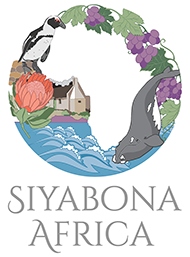Words by Fiona McIntosh
Photographs by Shaen Adey

Table Mountain Activities
Authors: Shaen Adey and Fiona McIntosh.
Copyright © 2004 Struik Publishers Cape Town.Table Mountain is called 'the Stone Man' or 'Grandfather' by many Capetonians and has a very special place in the hearts of the people who dwell in its shadow. And, not surprisingly, over the years strange tales have been told about this, well - it's more than a hunk of rock - this presence, this personality.
Van Hunks and the Devil
Old Jan van Hunks was a retired sea captain who liked to smoke his pipe of a morning and, for some reason, used to do so on the slopes of the mountain we now call Devil's Peak. This was long before our current anti-tobacco laws so perhaps he was just a considerate old fellow. Or perhaps it wasn't tobacco he was smoking? Whatever. One day, as he was sitting comfortably puffing away, a strange-looking fellow turned up and asked him for a light.Being a friendly sort, Van Hunks obliged. Then, for reasons that only highly competitive testosterone-driven men might understand, the stranger challenged him to a smoking competition and Van Hunks accepted. They both refilled their pipes and started puffing away, blowing smoke rings and generally trying to out-macho each other. After a while, the cloud of smoke grew so thick it covered the whole of the mountain like a giant tablecloth, which it still does today when the famous Southeaster is blowing.Eventually the stranger conceded defeat and stumbled, coughing and spluttering, off the mountain into the nearest thoracic Intensive Care Unit. As he was leaving, Van Hunks caught sight of his red, barbed tail sticking out from underneath his jacket and realised he had been puffing away with the devil. There's supposed to be a moral of sorts in this story but no-one's sure exactly what it is - and, of course, no-one is entirely sure what the competition's stakes were either.The devil still ended up having the peak to the east of Table Mountain named after him. Umlindi Wemingizimu. From the Cape Flats, if you use your imagination, squint ever so slightly and, perhaps, partake of whatever it was Van Hunks had in his pipe, you will see that Table Mountain, specifically Devil's Peak and Constantiaberg, resembles a sleeping giant. And this giant has a fascinating history. According to African legend, the earth was created by Qamata, who was the child of the sun god, Tixo, and the earth goddess, Djobela.As part of his land reclamation scheme, Qamata tried to create more and more dry land above the waves, a massive task in which he was severely hampered by the interference of the fearsome sea dragon, Nganyaba.
Qamata's mother noticed he was struggling so she created four giants to help him keep the sea at bay - one in the north, one in the south and one each to the east and west. After many fierce battles, which obviously enabled Qamata to create a sufficient amount of dry land, the giants were turned to stone and continued to keep watch over the land.
The southernmost of them, Umlindi Wemingizimu - The Watcher of the South - became Table Mountain. It would appear that he is doing his job admirably as, over the centuries, Cape Town has remained safe from the sea dragon ever since.
Adamastor and Vasco da Gama
The northern part of the world has a different creation myth. The sky, Uranus, and the earth, Gaea, together had a number of children, among whom were the Titans who ruled the earth in an atmosphere of mutual distrust. Brother fought brother and fathers ate their children in a doomed attempt to hang onto power.
Eventually Zeus, with the help of Poseidon and Hades, managed to overcome the Titans and banished them - some to the gloomy underworld of Tartarus, some to a British Island in the far west (probably the Outer Hebrides) and one, poor old Adamastor, to the southern end of the world, where he was imprisoned in stone. You guessed it - Table Mountain.
Now, your average battle-hardened Titan finds it a bit boring to spend a few millennia sleeping under a blanket of fynbos. So Adamastor, in order to give his life some meaning, took it upon himself to protect the continent of Africa. And, sure enough, after a few thousand years, he found himself going head-to-head with the Portuguese navigator Vasco da Gama (if the sixteenth century adventurer and poet, Luís Vaz de Camões can be believed).Da Gama did great battle with Adamastor, who tried to prevent him from rounding the Cape by throwing up storm after storm and terrifying the superstitious sailors into the bargain. The many interpretations of this story are more interesting than the story itself. As told by Camões, it was a rollicking adventure celebrating the bravery of the Portuguese sailors. As seen by many more contemporary scholars, it is an allegory of the attempt of modern people and their technology to overcome nature, and the doomed effort of nature to resist.
Still another way of looking at the story is as a racist and colonial epic. The 'virtuous' Christian Portuguese sailors successfully subjugate a heathen nation and place the whole continent of Africa (and incidentally the East) under the fledgling imperial yoke of Portugal and, of course, the Catholic Church.

